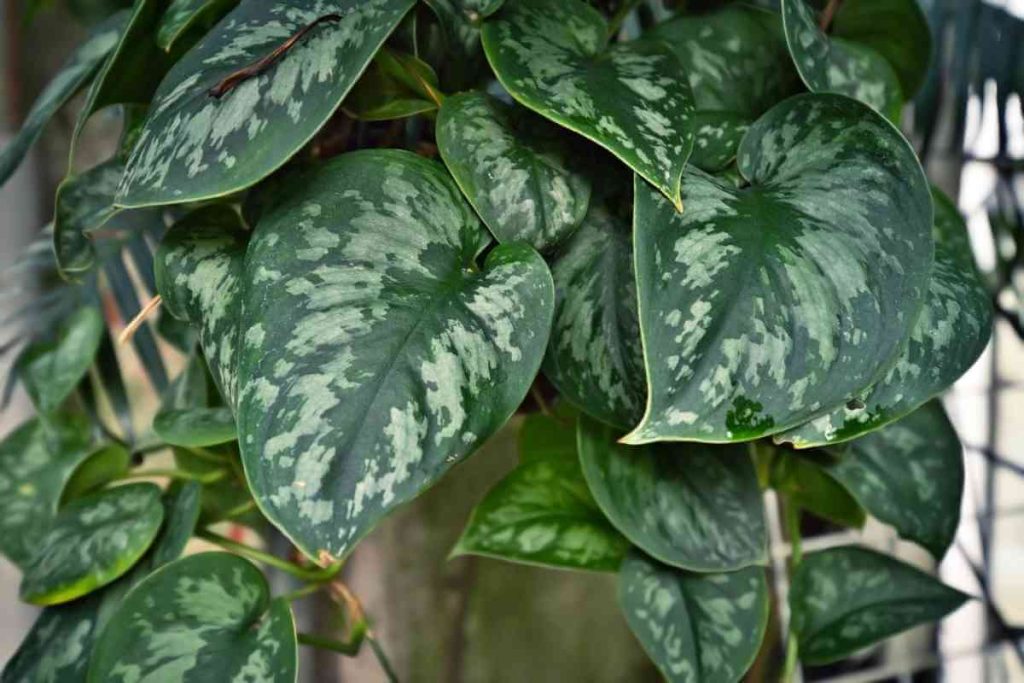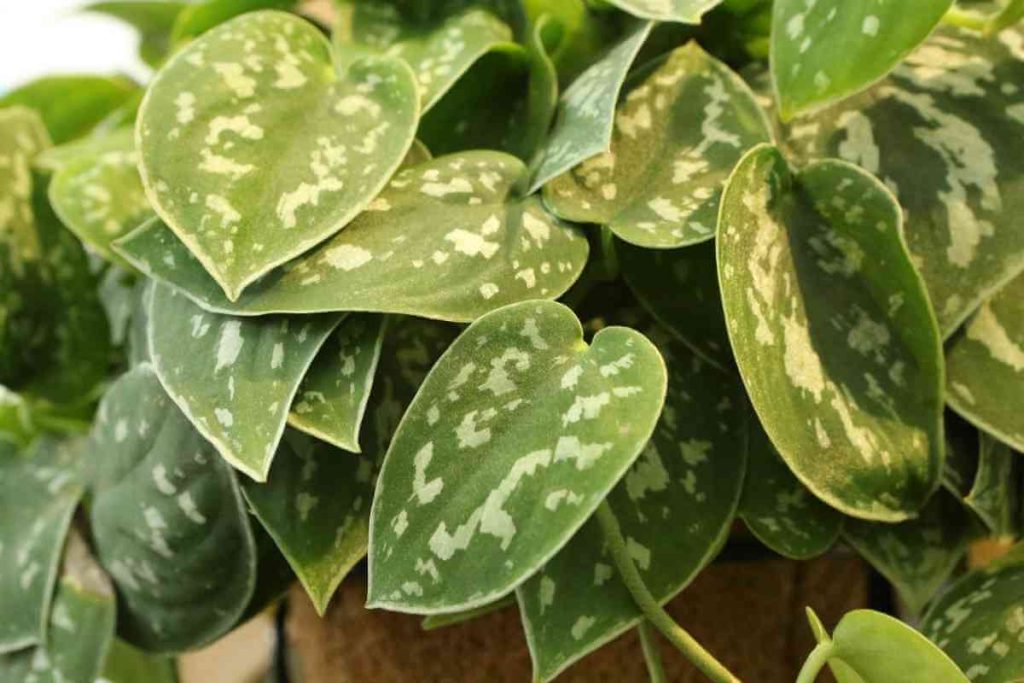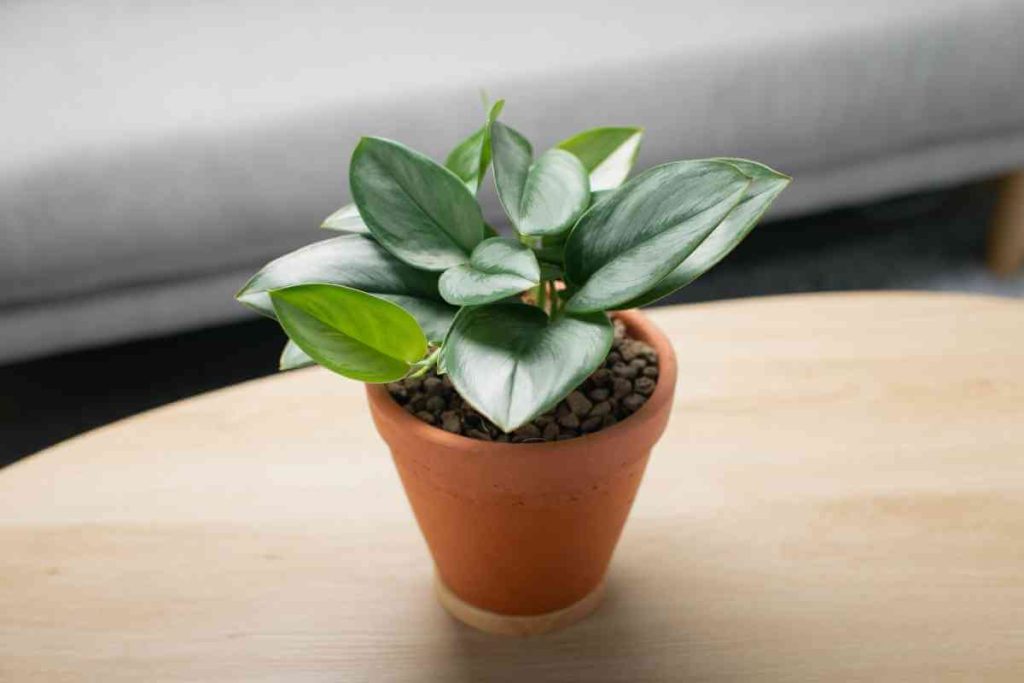The Scindapsus is a southeast Asian native plant, though it can also be found in the pacific islands, Queensland and New Guinea. It is known for being one of the easiest houseplants to care for.
Scindapsus is recognized for its fast-growing trailing vines and heart-shaped matte leaves that are speckled with iridescent gray dots. Depending on the environment, a mature Scindapsus plant can produce vines up to 10 feet long.
The genus name comes from the Greek word ‘skindapsos,’ which means “upon tree trunks” in reference to the plant’s growth pattern.
Scindapsus thrives in the wild as an epiphyte, attaching itself to tree trunks and limbs via aerial roots. As a result, it’s an excellent specimen to train to climb a coir pole or arrange on a ledge or shelf as a trailing plant!
This article will go over where you may find Scindapsus in the wild, the origin of the Scindapsus plant, the different Scindapsus varieties, and how to care for them (spoiler alert: most Scindapsus are super easy to care for!)
Table of Contents
Scindapsus Origin: What Is Scindapsus Plant?
Scindapsus is a flowering plant genus in the Araceae family. Southeast Asia, new guinea, Queensland, and a few western pacific islands are home to this species. Scindapsus pictus is a commonly cultivated plant.
Scindapsus and Epipremnum are difficult to separate. The number of seeds produced by the two genera is the fundamental distinction between them. Each ovary in the Scindapsus species has one ovule, but Epipremnum species contain a few.
Scindapsus seeds are spherical to kidney-shaped in form. Root climbing vines make up the majority of the plants.
Scindapsus pictus is a popular houseplant that may be purchased. It is quite easy to care for, as it is identical to the regular pothos (Epipremnum aureum).
Pictus means painted, and it got that name because of the lovely silvery spots of variegation that splatter across its leaves.
Different Scindapsus Varieties
Let’s have a look at some of the numerous Scindapsus varieties available.
Scindapsus pictus is a popular houseplant that may be purchased. It is quite easy to care for, as it is identical to the regular pothos (Epipremnum aureum).
Pictus means painted, and it got that name because of the lovely silvery spots of variegation that splatter across its leaves.
There are four popular kinds to choose from:
1. Scindapsus pictus argyraeus

The most common variety of Scindapsus is Scindapsus pictus argyraeus, which is lovingly known as “argy.”
The leaves are a darker green color with small silver speckles and splotches. The leaves on argy are a little smaller than those on other Scindapsus kinds, but they trail attractively. The leaves’ edges are also silver.
2. Scindapsus pictus silvery ann

Anne is a great beauty! She has a similar appearance to argyraeus, and at first glance, you might mistake them for the same plant. It’s difficult to tell them apart, especially if the plant is young and lacks much variegation.
Scindapsus pictus silvery Anne, like argyraeus, has smaller, dark green leaves. The green and silver sections, on the other hand, have a bit more contrast. Some leaves are almost totally silver or appear to be “dipped” in silver.
3. Scindapsus pictus exotica

Large leaves with brilliant splashes, speckles, and splotches of silver can be found on this very attractive Scindapsus pictus species. The leaves might have a jade green color, bordering on mint.
Like the silver splash kind described below, some of the leaves can appear pixelated. The stems of Scindapsus pictus exotica plants are likewise fairly thick.
4. Scindapsus pictus silver splash

If they aren’t sitting directly next to one another, Scindapsus pictus silver splash is quite easy to confuse with exotica. Exotica occasionally features highly pixelated variegation, making it look like a silver splash.
However, when you look closely, you can see the difference between the two. The leaves have a lot of silver on them, and it almost blends in with the green. Between silver and green, there is a less distinct shift.
A rare species of Scindapsus that isn’t a part of the Scindapsus pictus family will be discussed below;
5. Scindapsus treubii

‘moonlight’ and ‘dark form’ are the two types of Scindapsus treubii now available. S. treubii has a narrower leaf shape than s. pictus varieties, but it still has an asymmetrical hook at the end.
Like Scindapsus pictus variants, Scindapsus treubii ‘moonlight’ thrives when the leaves are allowed to curl before watering.
Scindapsus treubii ‘dark form,’ on the other hand, does not curl its leaves like Scindapsus pictus variations.
Know how to water it by looking at how lush the leaves are. The plant is fully hydrated when the leaves are tough and shiny. When the leaves become a little less robust and appear wrinkled and dull, the plant needs to be watered.
How to Care For Scindapsus Plants
- Sunlight: Year-round, provide strong, indirect light for Scindapsus plant. Its leaves will be scorched by direct sunshine, but too little light will cause the leaves to lose their variegation.
- Humidity: maintain a relative humidity of 40-50 percent around your plant. If the air is dry in the winter, use a room humidifier or a humidity tray.
- Temperature requirements: temperatures range from 65 to 85 degrees Fahrenheit (18 to 29 degrees Celsius) on average. Even if just for a short time, don’t expose the Scindapsus plant to temperatures below 60°f/16°c since cold air will damage the tropical plant’s foliage.
- Soil: use an all-purpose potting mix for your houseplants.
- Watering: allow the soil to dry out between waterings. Water every 1-2 weeks. Watering should be done more frequently in a better light and less frequently in lower light.
In general, the Scindapsus plant is a rather laid-back plant. There is curling and wilting of leaves when a plant is under-watered. The symptoms include yellowing foliage and damp potting soil.
If swallowed, this plant can be poisonous. Scindapsus plants should always be kept out of reach of little children and pets.
Frequently Asked Questions
How many species of Scindapsus are there?
Scindapsus is an aroid genus of roughly 35 species in the Araceae family. This genus is closely linked to Epipremnum and consists of evergreen perennials with climbing tendencies.
What are the different types of Scindapsus?
Below are 7 different Scindapsus varieties
- Scindapsus pictus argyraeus
- Scindapsus pictus silvery anne
- Scindapsus pictus exotica
- Scindapsus pictus silver splash
- Scindapsus pictus silver lady
- Scindapsus treubii moonlight
- Scindapsus treubii dark form
Are scindapsus and pothos the same?
What’s the difference between Scindapsus and pothos on a technical level?
Both belong to the Araceae, or aroid, family of plants. Pothos is a genus inside the Epipremnum genus, whereas Scindapsus is separate. (although the pothos was once known as Scindapsus aureus!).
In terms of development, Scindapsus plants contain one ovule per ovary, but Epipremnum plants have several. Scindapsus leaves are slightly thicker than pothos leaves, with a rough silver shine.
What is the rarest Scindapsus?
Scindapsus treubii is the only species of Scindapsus that is rare.
Is scindapsus tropical?
Scindapsus is one of many tropical vines widely grown for our industry. Scindapsus, Epipremnum, and philodendron are all members of the Araceae family. They come in many different sizes, shapes, and colors.
Is Scindapsus a climber?
Climbing vines, Scindapsus plants can reach a height of 10 to 40 feet (three to 12 meters), depending on the variety. Because they are so easy to grow, many varieties of Scindapsus have become popular houseplants. However, they are poisonous, so use caution.
Are Scindapsus fast growers?
This plant grows quite quickly. It can be slow to get going at first, but if it’s happy, it’ll really take off. Scindapsus pictus should be repotted every 1–2 years to a larger pot.
Where is Scindapsus native to?
Southeast Asia, new guinea, Queensland, and a few western pacific islands are home to this species.
Is Scindapsus an argyraeus?
The evergreen flowering plant Scindapsus pictus ‘argyraeus’ belongs to the genus Scindapsus and the family Araceae.
Should you mist Scindapsus?
It’s best to keep your Scindapsus plant in bright indirect light, and you may improve the humidity by spraying the plant several times weekly with room temperature water.
How do you propagate Scindapsus?
Cuttings are typically used for propagation in the spring, and roots take 4 to 6 weeks. Because water-grown roots are difficult for the plant to adapt into the soil, a potting mixture is employed instead of water. As a result, soil propagation in the spring has a higher success rate. The process entails cutting 3- to 4-inch-long tips.
Conclusion
In a nutshell, Scindapsus plants require a little more upkeep than Epipremnum pothos. While they have similar development patterns, Scindapsus plants have significantly thicker stems and leaves.
They also grow slower and are more susceptible to neglect than Epipremnum pothos plants. While you’ll probably be ok caring for the plants, there are a few differences to be aware of in the same manner.
Related Posts:




